Abstract
Contemporary climate challenges and energy security issues once again demonstrate that the transition to alternative motor fuels is a key and priority task for ensuring sustainable development in European Union countries, as well as in Ukraine. This review provides a comparative analysis of the physical, chemical, and performance properties of biodiesel fuels derived from 17 lipid-based feedstocks, including vegetable oils, animal fats, food industry waste, and microalgae. This study investigates the influence of fatty acid composition and transesterification alcohol type on key fuel properties, including density, viscosity, cetane number, pour point, heat value, and flash point. The results show that biodiesel fuels with a high content of saturated fatty acids exhibit higher cetane numbers and energy content, while biodiesel fuels with a high content of unsaturated fatty acids possess improved viscosity and cold flow properties. Camelina, rapeseed, and used cooking oil are identified as being particularly promising feedstocks based on their performance and availability in the European and Ukrainian dimensions. These findings are supported by a SWOT analysis and cost–benefit comparison, providing practical insights into the feasibility and scalability of biodiesel production pathways.
Keywords:
biodiesel; lipid biomass; vegetable oil; animal fat; fatty acid; alcohol; composition; properties 1. Introduction
In the context of global warming, rising oil prices, and the depletion of traditional energy resources, biofuels remain one of the most essential solutions, serving as an environmentally friendly and renewable alternative to petroleum diesel. Both the European Union (EU) and Ukraine have prioritized the transition to low-carbon energy as part of their climate, energy, and security strategies. The EU’s European Green Deal targets climate neutrality by 2050, with intermediate goals such as a 55% reduction in greenhouse gas emissions by 2030. As of 2023, biodiesel accounted for nearly 69% of the biofuels used in EU transport, although its share remains below the 2030 targets outlined in the Renewable Energy Directive (EU/2023/2413) [1,2,3,4].
Ukraine is aligning its energy policy with EU standards under the Green Deal Ukraine initiative, aiming to reduce emissions by 65% by 2030, particularly in relation to biofuels, which play a key role in decarbonizing the transport and agriculture sectors. Recent EU support packages for Ukraine emphasize renewable energy development to strengthen energy independence and integration with the EU market [5,6].
Taking the abovementioned into account, biodiesel production and use are permanently relevant issues. Biodiesel offers a viable solution for decarbonizing the transport sector, reducing greenhouse gas (GHG) emissions, utilizing local agricultural and waste resources, and reducing reliance on imported fossil fuels. For Ukraine, which has abundant farmland and significant volumes of food industry waste, biodiesel represents a strategic opportunity to contribute to national energy security, environmental sustainability, and economic recovery.
Numerous studies and reviews have been devoted to varying aspects of biodiesel production and use. These studies have provided valuable insights into the evolution and intensification of transesterification processes [7,8,9], engine compatibility emissions and feedstock classification [9,10]. However, many of them have become outdated. Usually, most of them are narrowly focused on specific regions or feedstock types, as well as production process optimization—especially those processes using methanol as an esterification agent—or do not comprehensively compare fuel properties across biodiesel generations or feedstocks. In contrast, this review provides an updated, side-by-side comparison of varying lipid-based feedstocks—including first- to fourth-generation sources—while also evaluating the influence of alcohol type. In addition to the comparative analysis of biodiesel properties, this review proposes both a SWOT analysis and cost–benefit assessment. Given recent trends in EU and Ukrainian energy policies, as well as the growing emphasis on advanced and waste-based biofuels, an integrated evaluation of biodiesel quality concerning feedstock sustainability and production potential is both necessary and timely.
The objective of this study is to systematically analyze the available feedstocks for the production of biodiesel and to compare the composition and main physical, chemical, and performance properties of biodiesel fuels obtained from different types of lipid feedstock.
This review is based exclusively on data collected from over 40 peer-reviewed scientific publications that analyzed the physical, chemical, and performance properties of biodiesel fuels derived from 17 different lipid-based feedstocks and three types of alcohols used for fuel synthesis. The analyzed scientific publications were published from 2006 to 2025, with a particular focus on recent studies from the period between 2023 and 2025. No original experimental measurements were performed. Instead, this study synthesizes data from multiple sources to compare trends across feedstocks and highlight key relationships between chemical structure and fuel performance. For each type of feedstock, values for the most critical parameters—such as density, viscosity, cetane number, pour point, heat of combustion, and flash point—were obtained from the literature. Only studies that used standardized testing methods (e.g., ASTM D6751, EN 14214) or reported experimental procedures were included to ensure data reliability. When multiple values were available for a given property, either the most representative or the average values were used. Although methodological differences across sources may influence absolute values, this review focuses on identifying comparative trends and relationships across feedstocks, thereby minimizing the impact of minor inter-study variations. This study did not account for the specific features of the technological processes used to obtain biodiesel fuel samples.
2. Current State of Biodiesel Production and Assessment of Feedstock Availability
Currently, biodiesel is produced from various feedstocks, such as vegetable oils, algae, animal fats, food industry waste, etc. Numerous studies have shown that biodiesel obtained from almost all types of renewable raw materials can be effectively used as an alternative fuel for diesel engines [7,8,9,10,11,12]. Today, the primary focus of biodiesel technology development is on increasing production by expanding the feedstock base, optimizing production processes, and enhancing operational characteristics in terms of both quantity and quality.
Determining the type of feedstock for biodiesel production is a key factor that affects production costs, processing methods, conversion efficiency, and environmental impact. Feedstock costs account for approximately 75–88% of the total production cost, making it a key aspect in assessing the economic feasibility of biodiesel [8]. The choice of raw materials influences the type of catalyst, technological parameters, process intensification methods, and purification procedures [9]. Biodiesel production is based on the use of various kinds of biomass, which can be divided into four generations, depending on their origin (Figure 1).
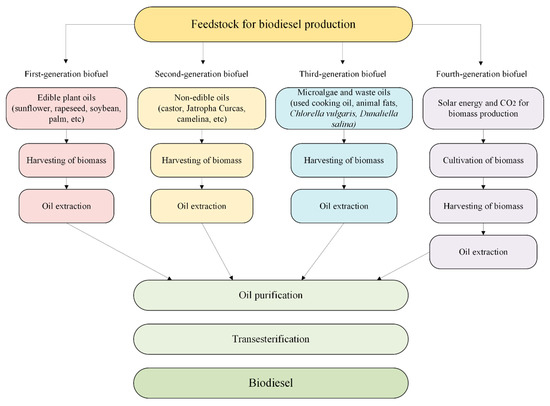
Figure 1.
Classification of feedstock for biodiesel production.
First-generation biomass includes commonly cultivated vegetable oils such as sunflower, rapeseed, soybean, palm, corn oils, etc., [10]. They are widely discussed in the literature, and their advantages include the availability of crops and the simplicity of the technological processes involved in their conversion. However, the primary disadvantage is that the use of these resources reduces food production, potentially leading to higher food prices [7,9].
Second-generation biomass mainly includes non-edible lipid materials, particularly non-food crops and vegetable oils, high-energy crops, and agricultural waste. It ensures the more efficient use of land resources and does not compete with the food industry. However, there are challenges, including low crop yields and some difficulties in organizing the technological production process [10,11].
Third-generation biomass includes waste oils or fats and algal biomass. Their main benefits include faster growth rates, increased efficiency, reduced impact on food resources, higher oil content, and lower demand for agricultural land. Moreover, their use allows for the effective utilization of various types of organic waste [12,13].
Fourth-generation biomass is used to obtain the most advanced and sustainable class of biofuels, aiming to overcome the limitations of earlier generations by integrating genetic engineering, carbon capture, and synthetic biology. They include genetically engineered microalgae, synthetic cyanobacteria, carbon-capturing plants, and waste gas fermentation organisms. However, most of these technologies are still at the pilot or early commercial stage due to high research and development costs, regulatory and public acceptance issues with GMOs, and the need for advanced bioreactor systems and infrastructure [9,12,14].
Each feedstock type presents unique advantages and challenges in terms of availability, processing requirements, fuel properties, and environmental impact. The selection of feedstock should consider local agricultural conditions, economic feasibility, and intended biodiesel application [6,15]. Table 1 summarizes the main features, such as the content of oil, fatty acid (FA) composition, advantages, and disadvantages, of some of the most popular representatives among the feedstocks mentioned above.

Table 1.
Some of the popular feedstocks utilized for biofuel production.
3. Fatty Acid Composition of Biodiesel Samples
The quantitative and qualitative composition of biodiesel fuels—and thus their performance—are strongly influenced by two main factors, i.e., the FA composition of the feedstock and the type of alcohol used during transesterification [14].
The carbon chain length, degree of saturation, and presence of functional groups in fatty acid esters directly affect key biodiesel properties such as cold flow behavior (e.g., pour and cloud points), viscosity and density, ignition quality (cetane number), oxidation stability, and energy content (calorific value) [40,41].
For the comparative analysis, a wide range of lipid feedstocks, which are actively used today for the production of biodiesel fuel, was analyzed. These 17 feedstocks were categorized into three groups according to their origin (Table 2).

Table 2.
Lipid feedstocks analyzed within this study.
The lipid content and FA composition of biodiesel feedstocks is quite diverse. For plant feedstocks, it can vary within one type of oil from several to ten percent. This is due to the growing conditions of oilseeds (crop variety, geographic region, seasonal cycles, soil type, irrigation, fertilizers used, etc.), species, and breed diversity. For instance, the oil content in sunflowers can range from 35% to over 50% depending on genotype and growing conditions. At the same time, the proportion of oleic vs. linoleic acid may shift with temperature and photoperiod [8,21]. Similar variability has been documented for rapeseed [15,19] and camelina [17,23]. The composition of microalgae oils is also influenced by a significant number of factors, including species and genetic modifications; growing conditions such as light, humidity, and temperature; the availability of nutrients in the environment; growth phase; storage; and processing conditions [44]. The lipid content and FA composition of animal fats are more similar, but they also vary depending on the species, breed, housing and feeding conditions, etc., [45,46]. This inherent variability introduces uncertainty in predicting biodiesel properties from a given feedstock and emphasizes the need for localized assessment when evaluating fuel quality and yield. Value ranges in Table 1 reflect variations in lipid content and the content of unsaturated FA of different feedstocks across the studied literature sources.
This diversity in FA profiles, as shown in Figure 2, Figure 3 and Figure 4, highlights the importance of feedstock selection tailored to application context (e.g., climate, storage duration, or engine type). It also suggests that blending biodiesels or modifying feedstock composition through breeding or cultivation techniques may optimize fuel properties for regional or industrial needs [42].
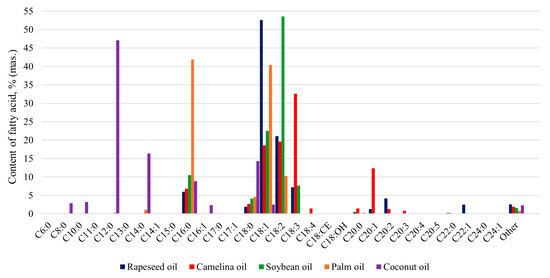
Figure 2.
Fatty acid composition of biodiesel fuels based on some edible oils.
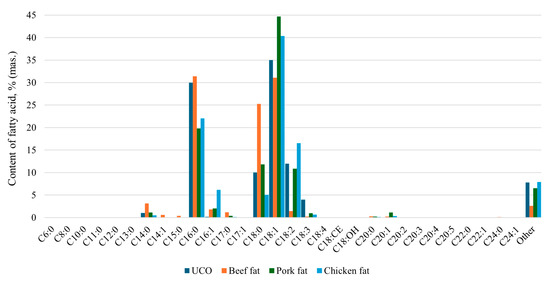
Figure 3.
Fatty acid composition of biodiesel fuels based on used cooking oil and animal fats.
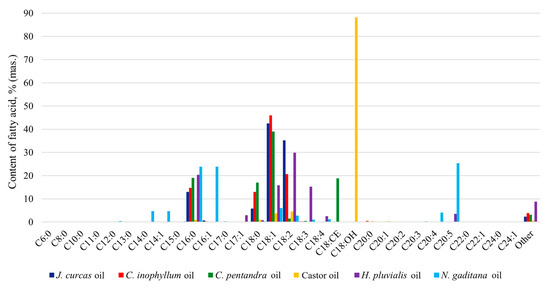
Figure 4.
Fatty acid composition of biodiesel fuels based on non-food and microalgae oils.
Figure 2 shows the fatty acid composition of the biodiesel samples obtained from some types of edible oils. As can be seen, the quantitative and qualitative content of fatty acids differ significantly. For example, coconut oil-based biodiesel contains FA esters with relatively short carbon chains (C6–C18), with saturated FAs predominating (about 95%). Palm oil-based biodiesel contains FA esters with longer carbon chains (C12–C20). Esters C16 and C18 represent the main part of them; at the same time, about 50% are unsaturated FAs with one or two double bonds. A more similar composition characterizes biodiesel based on rapeseed, camelina, and sunflower oils—they contain esters with a carbon chain of C16–C22, primarily C18, where the bulk (more than 80%) is unsaturated FAs with one, two, and three double bonds. The Table A1 shows the diversity of molecular structures of the dominant FA esters found in biodiesel derived from different lipid-based feedstocks.
Figure 3 shows the FA composition of the biodiesel samples obtained from secondary lipid-containing feedstock—UCO and animal fats. Compared to edible oils, the composition of animal fat-based biodiesel is more similar and homogeneous. Thus, their composition is dominated by C14–C20 FA. The main share is made up of saturated FAs C16:0 (20–32%) and C18:0 (5–25%), as well as unsaturated FAs C16:1 (up to 6%), C18:1 (31–45%), and C18:2 (10–16%). Beef fat-based biodiesel is characterized by a relatively lower content of unsaturated FA compared to other samples. Biodiesel based on animal fats also contains a small amount of FAs that are atypical for vegetable oils (C11, C13, C15, and C17).
Figure 4 shows the FA composition of biodiesel samples obtained from non-edible oils and microalgae oils. As can be seen from the graph, the composition is quite diverse and varies within a fairly wide range for different fuel samples.
The composition of biodiesel based on non-edible oils of J. curcas, C. inophyllum, and C. pentandra plants is generally typical for most vegetable oils, i.e., esters of unsaturated FAs C18:1 and C18:2 (40–88%), as well as saturated FAs C16:0 and C18:0 (19–36%), along with a small proportion of other FAs with a carbon chain length of C12–C24, are predominant. A specific feature of Ceiba Pentandra oil is its significant content of esters of malvalic (cyclopropene) FA C18:CE, which contains a propene ring in its structure. Castor oil biodiesel is mainly represented by esters of FA C18:1(OH) (more than 88%), i.e., ricinoleic acid with a hydroxyl group, with a small amount of esters from unsaturated FAs C18:1 and C18:2 (up to 9%), as well as some saturated FAs. The samples of biodiesel based on microalgal oils differ significantly from each other. For example, the composition of esters of H. pluvalis oil is dominated by unsaturated FAs C18:1–C18:4 (up to 65%) and saturated FA C16 (up to 20%). The composition of N. gaditana oil is dominated by saturated FA C:16 (up to 24%), unsaturated FA C16:1 (up to 24%), and unsaturated FA C20:5 (about 25%), with a noticeable content of other FAs in the range from C:11 to C:20.
This chemical composition and the difference in the structure of the FA esters’ molecules determine the properties of biodiesel and their compatibility with traditional diesel fuels. Next, the main physical, chemical, and performance properties of biodiesel based on different types of lipid feedstocks were analyzed.
4. Properties of Biodiesel Based on Different Types of Lipid Feedstock
Among the indicators of both petroleum diesel and biodiesel, which largely determine its operational properties, the leading physical—chemical indicators include [6,16,49] the following:
- Cetane number, which affects the power and efficiency of the engine;
- Fractional composition, which determines the completeness of combustion, smoke, and toxicity of exhaust gases;
- Viscosity and density, which ensure regular fuel supply, atomization in the combustion chamber, and efficiency of the filtration system;
- Low-temperature properties that affect the operation of the power system at low ambient temperatures;
- Degree of cleanliness, which characterizes the reliability of coarse and fine filters and the engine cylinder-piston group;
- Flash point, which determines the conditions for the safe use of fuel in diesel engines;
- The presence of sulfur compounds, unsaturated hydrocarbons, and metals that affect the formation of soot, corrosion, and wear of engine parts.
To investigate the influence of feedstock on the properties of fuel, we analyzed biodiesel samples received from various lipid biomasses and alcohols (methyl, ethyl, and n-butyl).
The molecular structure of the constituent fatty acid alkyl esters largely determines the physical, chemical, and performance properties of biodiesel. Key structural parameters include the FA chain length, degree of saturation, and presence of functional groups such as hydroxyl or epoxy groups. Additionally, the alcohol moiety (methyl, ethyl, or butyl) in esters influences properties like density and pour point due to changes in molecular size, branching, and volatility. Understanding these structure–property relationships is essential for tailoring biodiesel blends with optimal performance and stability for specific applications.
While this study focuses on the most common alcohols—methanol, ethanol, and n-butanol—emerging research has shown that alcohols such as pentanol, hexanol, and branched alcohols (e.g., iso-butanol and iso-pentanol) can further modify biodiesel properties. These alcohols tend to increase the molecular weight and branching of the resulting esters, leading to a lower density, pour points, and a higher lubricity. However, they may also increase viscosity and production cost. Their lower polarity may also improve miscibility with fossil diesel. However, the industrial application of such alcohols remains limited due to availability and cost constraints.
4.1. Density
Figure 5, Figure 6 and Figure 7 show a comparison of the density values of biodiesel based on methyl esters (MEs), ethyl esters (EEs), and n-butyl esters (BEs) of different types of oils and fats. As can be seen from the figures, all biodiesel samples exhibit a higher density compared to traditional diesel fuel, which is attributed to differences in their molecular structure.
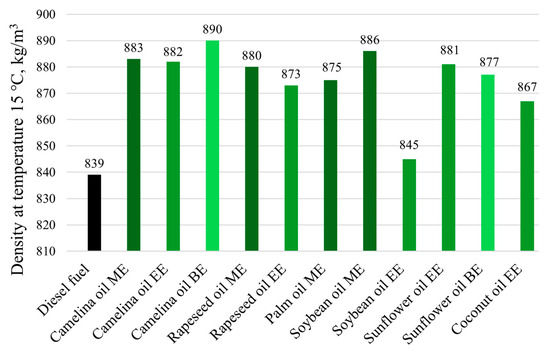
Figure 5.
Density of biodiesel fuels based on some edible oils.
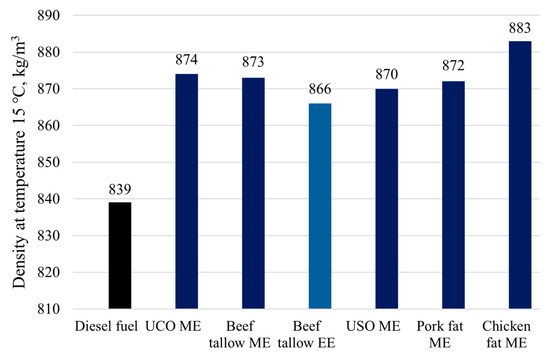
Figure 6.
Density of biodiesel fuels based on used cooking oil and animal fats.
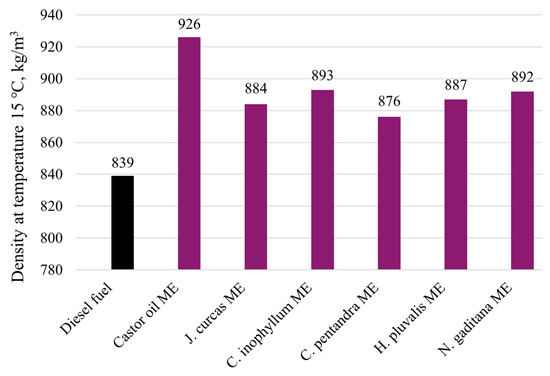
Figure 7.
Density of biodiesel fuels based on non-edible oils and microalgae oils.
The vast majority of biodiesels have a density in the range of 866–895 kg/m3, which fully meets the requirements of biodiesel fuel specifications [50,51,52]. The density of biodiesel fuels is primarily influenced by the molecular structure of their constituent fatty acid esters, particularly the chain length and degree of unsaturation. Saturated esters with longer carbon chains tend to have higher densities due to tighter molecular packing, while the presence of double bonds (unsaturation) introduces kinks in the chains that reduce packing efficiency and thus lower the density. High atypical values are observed for castor oil MEs (926 kg/m3), which correlates with its atypical FA composition. The hydroxyl group in the structure of ricinoleic acid MEs significantly increases polarity and intermolecular hydrogen bonding, leading to a higher density. Analyzing the data, it can be observed that lipid biomass with a heavier FA composition (characterized by a longer average carbon chain length) results in higher fuel density values. A visible effect of the type of alcohol used for biodiesel synthesis is also observed. The use of alcohols with a higher number of carbon atoms leads to a decrease in density. This is observed due to the increase in molecules’ volume with the rising length of the alcohol radical and, therefore, the less-efficient packaging of molecules in liquid. This indicates a positive effect of higher alcohols on biodiesel density, making them more similar to petroleum diesel.
4.2. Viscosity
Next, the influence of lipid biomass type and alcohol used for synthesis on the viscosity of biodiesel was analyzed (Figure 8, Figure 9 and Figure 10). It may be observed that the viscosity values of all biodiesel samples vary, on average, in the range of 4–7 mm2/s and are significantly higher than those of petroleum diesel fuel (by 2–3 times). Such values mostly meet the requirements of the standard specifications for biodiesel fuels that define viscosity values in the range of 3.5–5.0 mm2/s [50,51,52]. Very-high viscosity values are observed for castor oil MEs (13.45 mm2/s). This is due to the peculiarities of its fatty acid composition, particularly the exceptionally high content of C18:1(OH) esters. Additionally, it was noted that biodiesel based on microalgal oils also has slightly higher viscosity values.
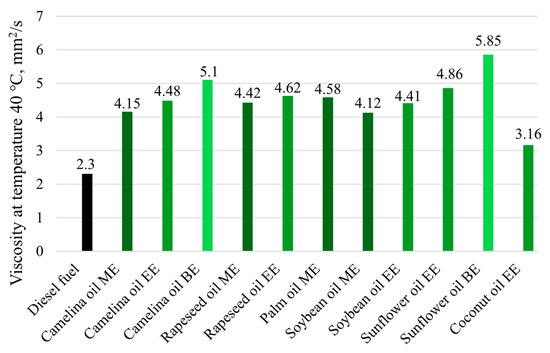
Figure 8.
Viscosity of biodiesel fuels based on some edible oils.
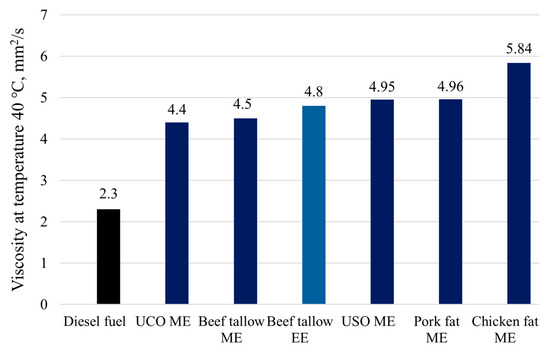
Figure 9.
Viscosity of biodiesel fuels based on used cooking oil and animal fats.
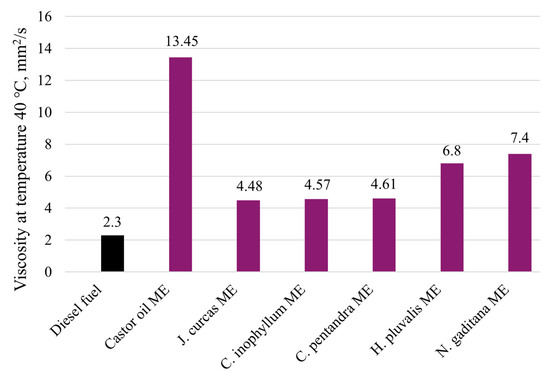
Figure 10.
Viscosity of biodiesel fuels based on non-edible oils and microalgae oils.
The viscosity of biodiesel fuels is strongly affected by the fatty acid structure. Esters with longer carbon chains and higher saturation exhibit increased viscosity due to stronger van der Waals interactions and enhanced molecular cohesion. The atypical viscosity value of castor oil MEs is also explained by the high content of ricinoleic acid, which results in high-polarity molecules.
There is also a noticeable dependence of viscosity values on the alcohol used for transesterification. The use of alcohols with a higher number of carbon atoms leads to an increase in the viscosity of the biodiesel. This dependence is observed in both vegetable oils and animal fats. The reason for this effect is the greater molecular weight and volume of ester molecules with the increase in alcohol radical size. This provides more surface area for intermolecular interactions, resulting in stronger van der Waals (dispersion) forces, which increase internal friction between molecules and resist their chaotic movement, increasing viscosity. At the same time, it is known that alcohols with more complex or branched structures may result in a reduction in viscosity due to the formation of curved molecule structures.
4.3. Pour Point
Figure 11, Figure 12 and Figure 13 show a comparison of the pour points of biodiesel samples based on different types of lipid biomass and various alcohols. The pour point values of the biodiesel samples differ significantly but generally exceed the values for petroleum diesel fuel. Regulatory documents do not establish a single requirement for the low-temperature properties of biodiesel; the maximum permissible values are determined by the season and climatic zone being used [50,51,52].
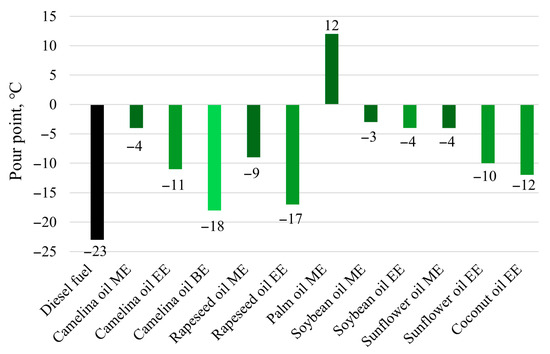
Figure 11.
Pour point of biodiesel fuels based on some edible oils.
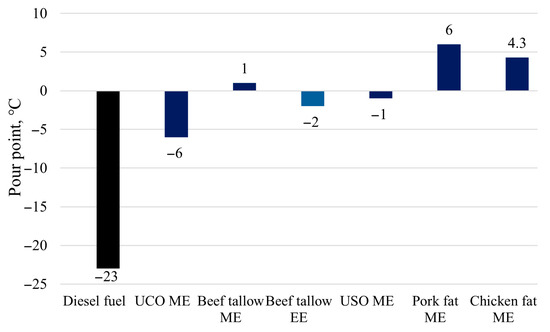
Figure 12.
Pour point of biodiesel fuels based on used cooking oil and animal fats.
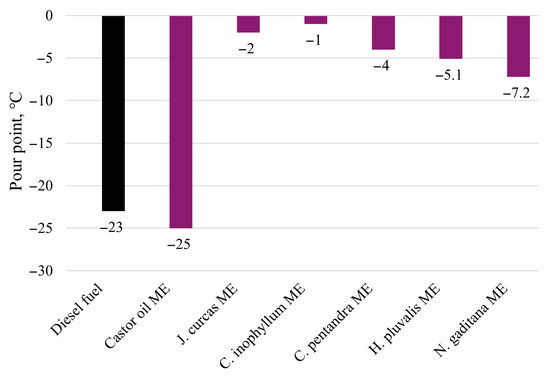
Figure 13.
Pour point of biodiesel fuels based on non-edible oils and microalgae oils.
From the data collected, it can be concluded that biodiesel based on animal fats and palm oil has the most unsatisfactory pour point, which, in most cases, is above 0 °C. On the contrary, the lowest pour point is that of castor oil esters (minus 25 °C), due to the high content of unsaturated FA esters. The pour point of biodiesel is mainly influenced by the degree of saturation and chain structure of the fatty acid esters. Saturated esters tend to crystallize at higher temperatures, leading to higher pour points, whereas unsaturated esters—especially those with cis double bonds—prevent early molecular packing while cooling and lower the pour point.
In addition, the structure of the alcohol used to produce the biodiesel has a significant impact on the change in the parameter. The use of alcohol with a higher number of carbon atoms in its structure provides a substantial reduction in the pour point of fuels. If methyl alcohol is substituted with ethyl alcohol for transesterification, the pour point can be reduced by up to 7 °C, which is similar to the case of butyl alcohol. This effect is achieved by increasing the degree of branching of ester molecules and through the less-compact packing of molecules during cooling.
4.4. Heat of Combustion
One of the most critical indicators of fuel quality is its calorific value or neat heat of combustion. Figure 14 shows a comparison of the calorific value of biodiesel samples based on different types of lipid biomass and various alcohols. The values of the neat heat of combustion of the biodiesel fuel samples are lower compared to the value for petroleum diesel fuel (on average by 5–8 MJ/kg).
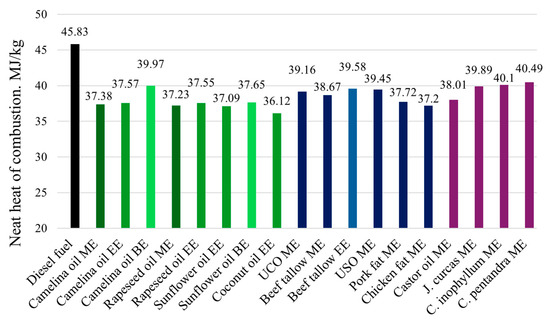
Figure 14.
Neat heat of combustion of biodiesel fuels based on different types of lipid biomass.
Although regulatory documents do not specify requirements for this indicator for biodiesel, it is evident that fuels with a higher calorific value will provide more energy and, thus, a more efficient engine operation [50,51,52]. In general, the heat of combustion of biodiesel samples varies in a relatively small range (36–40 MJ/kg). Such differences are due to the FA composition of the initial lipid biomass. The lower calorific value of esters compared to petroleum diesel fuel is explained by the presence of oxygen atoms in their composition. The heat of combustion of esters generally increases with the length and saturation of the FA chain. Saturated, long-chain esters store more chemical energy and release more heat upon combustion. In contrast, unsaturated esters, particularly those with multiple double bonds, have a lower energy content due to the presence of lower-energy double bonds. It should be noted that the use of alcohols with a more complex structure (i.e., those containing a larger number of carbon atoms) has a positive effect, providing a slight increase in the calorific value of fuels. This is explained by the fact that with the rising length of the alcohol radical, the mass ratio of hydrogen, which releases the biggest amount of energy during combustion, in biodiesel is greater, and oxygen is lower.
4.5. Cetane Number
The cetane number is an indicator that characterizes the ability of diesel and biodiesel fuels to self-ignite. It determines the period of ignition delay, i.e., the time spent on spraying the fuel, its evaporation and mixing with air, and the formation of a self-ignition flame. The cetane number characterizes the flammability of fuels and affects the engine operation mode (start-up, rigidity of the working process (pressure increase rate), fuel consumption, smokiness of exhaust gases).
Figure 15 shows a comparison of the cetane number values of biodiesel fuel samples based on different types of lipid biomass and various alcohols. In general, the cetane number values of the biodiesel samples are relatively higher than those of petroleum diesel fuel, ranging from 50 to 68 units. The cetane number of biodiesel is mainly determined by the FA chain length and degree of saturation. Longer, saturated esters ignite more readily under compression and therefore have higher cetane numbers, while unsaturated esters—especially those with polyunsaturated chains—exhibit a lower ignition quality due to the presence of double bonds that slow down combustion initiation. In addition, the presence of oxygen atoms in the structure of molecules has a positive effect on the completeness of the combustion of biodiesel.
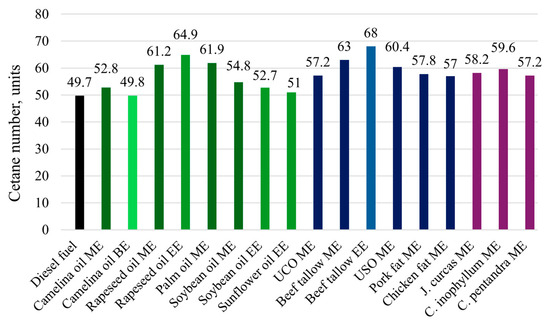
Figure 15.
Cetane number of biodiesel fuels based on different types of lipid biomass.
Regulatory documents define the minimum cetane number for biodiesel as 51 units [49,50,51]. Thus, it can be concluded that most of the analyzed biodiesel fuels meet this requirement. No visible dependance of the alcohol type on the cetane number of biodiesel was found. However, some of the studies reported that the use of higher alcohols for biodiesel production may positively affect the cetane number due to the increase in molecular chain length and the reduction in oxygen content.
4.6. Flash Point
The flash point is one of the critical parameters that characterizes the quality of motor fuels, including biodiesel, in terms of their fire and explosion hazard. High flash point values allow for a range of technological operations with fuels (storage, pumping, transportation, refueling, etc.) with a high degree of safety for both the environment and personnel.
In general, biodiesel fuels based on FA esters of various lipid biomass are characterized by relatively high flash points, which usually exceed the corresponding values of petroleum biodiesel (Figure 16 and Figure 17). This is primarily due to the differences in the composition and molecular structure of biodiesel and conventional diesel fuel, particularly in terms of higher molecular weight and lower volatility.
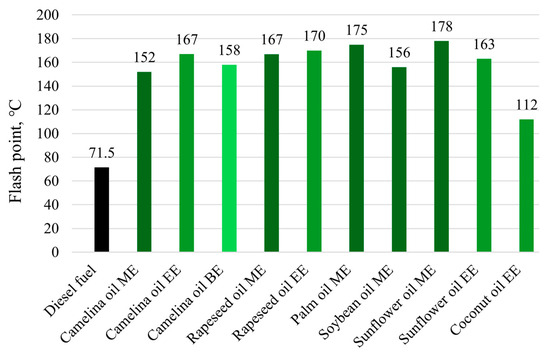
Figure 16.
Flash point of biodiesel fuels based on some edible oils.
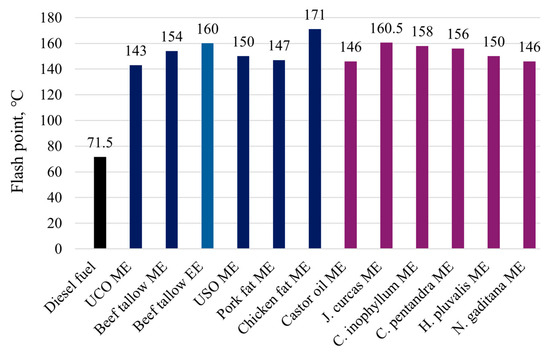
Figure 17.
Flash point of biodiesel fuels based on animal fats, non-edible oils, and microalgae oils.
As can be seen from the data in Figure 16 and Figure 17, biodiesel fuels are characterized by relatively high flash point values, varying, on average, between 145 and 175 °C. The differences are primarily due to differences in the quantitative and qualitative content of individual FA esters in the fuel. At the same time, no significant effect of the type of alcohol on this indicator was noted. In general, all samples of biodiesel fully meet the requirements of existing regulatory documents [50,51,52].
4.7. Oxidative Stability
Oxidative stability is a critical property that determines the shelf life and storage behavior of any fuel, including biodiesel. It refers to the resistance of biodiesel to react with atmospheric oxygen, forming peroxides, acids, gums, and sediments that degrade fuel quality and harm engine components during operation. The FA composition primarily determines this property. Biodiesel with a high content of unsaturated FA (e.g., linoleic or linolenic acid) has a higher tendency for oxidation than biodiesel composed of saturated FAs [6,16,47]. This is due to the presence of one or multiple double bonds in the molecular structure that are more easily oxidized. For instance, fuels derived from sunflower, soybean, and camelina oils, which have high levels of polyunsaturated esters, typically exhibit a poor oxidative stability. In contrast, biodiesel received from palm, coconut oil, or animal fats demonstrates a superior oxidative stability due to higher saturation levels [47]. To meet standard requirements on the oxidative stability of biodiesel [50,51,52], antioxidants, either natural or synthetic, are often added during its production or storage. While not all reviewed sources report the oxidative stability values, the trends generally correlate well with the degree of unsaturation discussed in the previous section.
4.8. Comparative Analysis of Benefits and Trade-Offs for Different Lipid Feedstocks
To facilitate a more practical understanding of how different lipid feedstocks influence biodiesel quality, the key physical, chemical, and operational properties of biodiesel derived from various raw materials are summarized in Table 3. This comparative overview highlights the performance of biodiesel in terms of density, viscosity, pour point, cetane number, and calorific value—critical parameters that affect engine compatibility, combustion efficiency, low-temperature operability, and storage stability. By outlining the advantages and limitations of each feedstock, this table aims to support the selection of optimal raw materials for biodiesel production under specific climatic and economic conditions.

Table 3.
Summary of the key physical, chemical, and operational properties of biodiesel derived from various raw materials.
Among the various lipid feedstocks assessed, rapeseed and sunflower oils emerge as some of the most balanced options, offering a favorable combination of high cetane numbers, acceptable cold flow properties, and well-established cultivation and processing systems [53]. These qualities make them particularly suitable for widespread biodiesel production in Europe and Ukraine.
Castor oil stands out for its exceptionally low pour point, attributed to its high content of ricinoleic acid, making it a strong candidate for use in colder climates. However, its unusually high viscosity presents significant challenges for engine performance and fuel handling, suggesting that it is best suited for blending with other biodiesel fuels or for use in specially adapted engines.
Palm oil and animal fats demonstrate the highest calorific values and cetane numbers, indicating strong energy content and ignition quality. Nevertheless, their poor cold flow properties, mainly due to their high degree of saturation, limit their suitability in colder regions without prior treatment or blending. Despite these drawbacks, their low cost and abundance—especially in the case of animal fats, as byproducts of the meat industry—make them economically attractive in specific contexts.
Used cooking oil and animal fats also offer substantial environmental and economic benefits through waste valorization and circular economy integration. However, their variable quality and higher free fatty acid content necessitate rigorous pretreatment to ensure consistent fuel quality.
From a sustainability perspective, camelina and microalgae represent up-and-coming long-term options. Camelina is a low-input, non-food oilseed crop that is well-suited to marginal lands, while microalgae offer rapid growth rates, high oil content, and minimal land competition. Although microalgae biodiesel is not yet commercially viable due to high production costs and technological constraints, continued research and development could position it as a key feedstock in the future.
Trade-offs are evident across feedstocks. Fuels rich in unsaturated fatty acids typically exhibit superior cold flow properties but lower oxidative stability. In contrast, saturated fatty acid-rich fuels offer higher cetane numbers and greater oxidation resistance at the cost of a poor low-temperature performance. Additionally, biodiesel derived from feedstocks with longer average carbon chain lengths tends to exhibit a higher density and energy content but often shows reduced volatility and increased viscosity. Understanding these trade-offs is essential for selecting or engineering feedstock compositions optimized for specific applications and regional needs [6,16].
As demonstrated in the preceding analysis, biodiesel fuel properties vary significantly depending on feedstock origin, processing method, and environmental context. To summarize these interrelated factors, Figure 18 presents a conceptual framework that identifies the primary drivers of variability in biodiesel fuel characteristics.
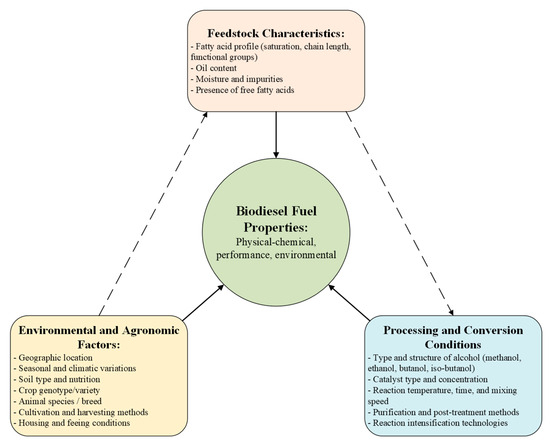
Figure 18.
Conceptual framework of key factors influencing biodiesel fuel property variability.
A combination of biological, environmental, and process-level factors influences biodiesel fuel properties. Accounting for this variability is essential for the accurate comparison and prediction of engine performance, long-term storage behavior, and environmental compatibility across feedstocks and regions.
Although the current study provides a comparative evaluation based on literature-derived values, it does not incorporate quantitative models to assess the variability of biodiesel fuels’ properties due to the factors mentioned earlier. This limits the predictive generalizability of the findings across production settings. However, this conceptual framework provides a foundation for applying statistical modeling techniques to capture how variations in feedstock composition affect biodiesel properties and environmental performance. Integrating such approaches would improve the robustness of biodiesel assessments for both policy planning and industrial deployment.
5. SWOT Analysis and Regional Considerations for Biodiesel Feedstocks
The development of biodiesel production and use in the European region and Ukraine is an essential step towards ensuring energy independence and reducing the negative impact on the environment. The introduction of modern technologies and the optimization of biodiesel production processes will help to increase the efficiency and environmental friendliness of the transportation sector [43,54]. Based on the best international practices of biodiesel production, a set of practical recommendations has been developed to facilitate the development of biodiesel production and use in Ukraine.
To support informed decision-making in the biodiesel sector, a SWOT analysis was developed for key feedstocks that are realistic options in both the Ukrainian and broader European contexts (Table 4). This study highlights the internal strengths and weaknesses of each feedstock, as well as external opportunities and threats that influence their potential for sustainable and economically viable biodiesel production.

Table 4.
SWOT matrix of key biodiesel feedstocks in Ukraine and Europe.
In Ukraine, rapeseed and sunflower oil remain the primary feedstocks due to their established cultivation, processing infrastructure, and export significance. UCO and animal fats represent underutilized waste streams with a high potential for circular economy integration. Microalgae and camelina are emerging candidates that offer promising long-term potential, particularly for marginal land use and energy independence strategies.
In the European Union, policy is increasingly focused on advanced biofuels with a minimal land use impact [48]. While rapeseed continues to be a key component of biodiesel blending strategies, its long-term viability is contingent on GHG reduction performance and sustainability concerns. UCO is already widely used in many EU countries and is seen as a preferred feedstock under the RED [48]. However, quality control, certification, and supply chain efficiency remain ongoing challenges.
A simplified cost–benefit comparison of biodiesel production using five representative feedstocks—rapeseed oil, UCO, animal fat, camelina, and microalgae—is presented in Table 5. These feedstocks were selected based on their availability, processing characteristics, and alignment with sustainability goals in both European and Ukrainian contexts. The table highlights variations in economic, technical, and environmental performance to support strategic feedstock selection for biodiesel production.

Table 5.
Cost–benefit comparison of selected biodiesel feedstocks.
As concerns the industrial development of biodiesel production technologies, it is advisable to scale up the facilities for the transesterification of fat-containing raw materials. In this case, it is recommended to use methanol or ethanol and alkaline catalysts for the transesterification of oils. Along with this, it is recommended to introduce methods to intensify the production of biodiesel fuels, such as microwave radiation, ultrasonic radiation, or supercritical transesterification.
6. Conclusions
This review provides a comprehensive comparative analysis of the physical, chemical, and performance properties of biodiesel fuels derived from various lipid-based feedstocks, with a focus on applications in the European Union and Ukraine. The study evaluated 17 feedstocks across multiple generations—including edible and non-edible plant oils, animal fats, waste oils, and microalgae—alongside the impact of alcohol type used in transesterification.
The key findings indicate that fatty acid composition plays a central role in determining the operational quality of biodiesel. Feedstocks with higher saturated fatty acid contents (e.g., animal fat and palm oil) offer higher cetane numbers and a better oxidation stability but suffer from poor low-temperature properties. Conversely, feedstocks rich in unsaturated fatty acids (e.g., sunflower and camelina) provide a better cold flow behavior at the expense of oxidative stability. The use of longer-chain or branched alcohols (e.g., butanol) further modifies key fuel parameters such as viscosity, pour point, and energy content.
From a performance perspective, rapeseed, sunflower, and used cooking oil emerge as the most balanced and readily available feedstocks in the Ukrainian and European context. Castor oil stands out for its excellent cold flow properties but poses challenges due to its extremely high viscosity. Microalgae and camelina represent highly promising feedstocks in the long term, aligning well with environmental goals and marginal land use strategies, though economic and technological barriers remain.
The SWOT analysis reveals that Ukraine has significant untapped potential in waste-based biodiesel, particularly from used cooking oil and animal fats, which align well with circular economy principles. Meanwhile, a cost–benefit analysis underscores that while microalgae offer the highest theoretical yields and environmental benefits, their commercial viability is limited at present.
To scale biodiesel production sustainably, Ukraine and similar regions should prioritize the following:
- Diversifying feedstock sources, especially incorporating non-food and waste-based oils;
- Supporting research and development in relation to high-yield, low-input crops like camelina and algae;
- Investing in decentralized infrastructure for processing local waste oils and fats;
- Aligning production practices with EU sustainability directives, especially RED III.
Ultimately, biodiesel offers a pragmatic, scalable, and increasingly sustainable pathway for reducing reliance on fossil fuels, enhancing rural economies and improving energy resilience in both Ukraine and the broader European region.
Although this review provides a comprehensive comparison of the physical, chemical, and performance-related properties of biodiesel derived from various feedstocks, it does not extend to engine performance or emissions testing. These aspects are critical for real-world validation and should be addressed in future studies that combine laboratory-scale fuel property analysis with standardized engine tests. Such integrated studies would enable a more precise evaluation of fuel behavior under operational conditions, especially in the context of regulatory compliance and air quality impacts. Another promising direction for future studies would be the research and comparative analysis of applying alternative higher alcohols for biodiesel fuel production. This could be a viable solution for the modification and optimization of biodiesel fuel properties for desired applications and meeting standard requirements while utilizing feedstock with an unacceptable composition.
Author Contributions
Conceptualization, A.Y. and S.B.; methodology, A.Y.; software, A.Y.; validation, S.Z. and I.S.; formal analysis, S.B.; investigation, A.Y. and S.Z.; resources, A.Y.; data curation, S.Z.; writing—original draft preparation, A.Y.; writing—review and editing, S.B.; visualization, A.Y.; supervision, S.B.; project administration, S.B. and I.S.; funding acquisition, S.B. All authors have read and agreed to the published version of the manuscript.
Funding
This research was funded by the Ministry of Education and Science of Ukraine (grant number 0124U000973) “Development of technological solutions for producing blended motor fuels from secondary feedstock to improve energy safety”.
Data Availability Statement
The original contributions presented in this study are included in the article. Further inquiries can be directed to the corresponding author.
Conflicts of Interest
The authors declare no conflicts of interest.
Abbreviations
The following abbreviations are used in this manuscript:
| BE | n-butyl ester |
| EE | Ethyl ester |
| FA | Fatty acid |
| GHG | Greenhouse gas |
| ME | Methyl ester |
| RED | Renewable Energy Directive |
| UCO | Used cooking oil |
| USO | Used sunflower oil |
Appendix A
Table A1 provides the representative molecular structures of the dominant FA esters found in biodiesel derived from the 17 lipid-based feedstocks discussed in this study. These include saturated, monounsaturated, and polyunsaturated esters, which reflect the characteristic FA profiles of the respective feedstocks.

Table A1.
Molecular structures of the dominant FA esters found in biodiesel derived from different lipid feedstocks.
Table A1.
Molecular structures of the dominant FA esters found in biodiesel derived from different lipid feedstocks.
| FA | FA Structural Formula | Feedstock Where FA Is Typically Found |
|---|---|---|
| C12:0 |  | Coconut oil |
| C16:0 |  | Palm oil, soybean oil, coconut oil, rapeseed oil, camelina oil, beef fat, pork fat, chicken fat, J. curcas, C. inophyllum, C. pentandra, N. gaditana oil, H. pluvalis oil |
| C18:0 |  | Coconut oil, beef fat, pork fat, chicken fat, J. curcas, C. inophyllum, C. pentandra |
| C18:1 | 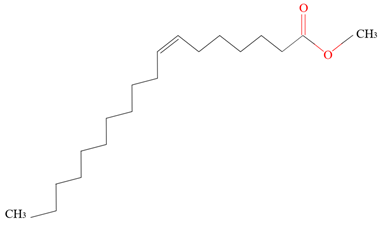 | Rapeseed oil, palm oil, soybean oil, camelina oil, beef fat, pork fat, chicken fat, H. pluvalis oil |
| C18:2 | 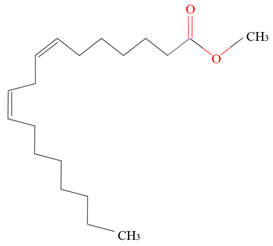 | Soybean oil, camelina oil, rapeseed oil, palm oil, pork fat, chicken fat, H. pluvalis oil |
| C18:3 | 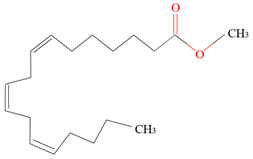 | Rapeseed oil, soybean oil, camelina oil, UCO, H. pluvalis oil |
| C18:1(OH) | 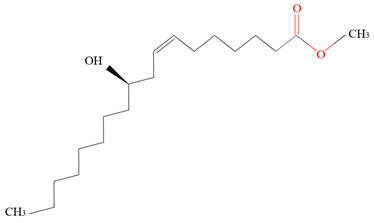 | Ricinoleic acid |
| C18:CE |  | C. pentandra oil |
| C20:0 |  | Camelina oil |
| C20:1 |  | Camelina oil, rapeseed oil |
| C20:5 | 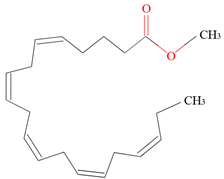 | N. gaditana oil, H. pluvalis oil |
References
- Gueye, S.; Karanfil, F.; Omgba, L.D. Navigating the energy transition in the EU: Renewables, critical raw materials and emerging vulnerabilities. Ecol. Econ. 2025, 237, 108696. [Google Scholar] [CrossRef]
- De Paula Leite, A.C.; Pimentel, L.M.; Monteiro, L.D.A. Biofuel adoption in the transport sector: The impact of renewable energy policies. Sustain. Energy Technol. Assess. 2025, 81, 104419. [Google Scholar] [CrossRef]
- De Paula Leite, A.C.; Pimentel, L.M.; de Almeida Monteiro, L. The impact of climate change policies on the biofuels sector: A stakeholder perspective. Energy Sources Part B Econ. Plan. Policy 2025, 20, 2477510. [Google Scholar] [CrossRef]
- Greenhouse Gas Savings from Biofuels; European Environment Agency: Copenhagen, Denmark, 2023.
- Renewable Energy Directive (RED III) Policy Updates; European Commission: Brussels, Belgium, 2023.
- Boichenko, S.; Yakovlieva, A.; Zubenko, S.; Konovalov, S.; Shkilniuk, I.; Artyukhov, A.; Wit, B.; Czarnocki, K.; Wołowiec, T. Properties of Components of Renewable Motor Fuel Based on Plant Oils and Assessment of Their Compatibility with Traditional Fuels. Energies 2024, 17, 6390. [Google Scholar] [CrossRef]
- Singh, N.; Saluja, R.K.; Jeevan Rao, H.; Kaushal, R.; Gahlot, N.K.; Suyambulingam, I.; Sanjay, M.R.; Divakaran, D.; Siengchin, S. Progress and facts on biodiesel generations, production methods, influencing factors, and reactors: A comprehensive review from 2000 to 2023. Energy Convers. Manag. 2024, 302, 118157. [Google Scholar] [CrossRef]
- Pranta, M.H.; Cho, H.M. A comprehensive review of the evolution of biodiesel production technologies. Energy Convers. Manag. 2025, 328, 119623. [Google Scholar] [CrossRef]
- Knothe, G.; Van Gerpen, J.; Krahl, J. The Biodiesel Handbook, 2nd ed.; AOCS Press: Champaign, IL, USA, 2015. [Google Scholar]
- Hoekman, S.K.; Broch, A.; Robbins, C.; Ceniceros, E.; Natarajan, M. Renewable diesel: A review. Prog. Energy Combust. Sci. 2012, 36, 144–166. [Google Scholar]
- Mata, T.; Mendes, A.; Caetano, N.; Martins, A. Properties and sustainability of biodiesel from animal fats and fish oil. Chem. Eng. Trans. 2014, 38, 175–180. [Google Scholar] [CrossRef]
- Sharma, A.; Jyoti, A.; More, A.; Gunjal, M.; Rasane, P.; Kumar, M.; Kaur, S.; Ercisli, S.; Gurumayum, S.; Singh, J. Harnessing Fruit and Vegetable Waste for Biofuel Production: Advances and Scope for Future Development. Efood 2025, 6, e70051. [Google Scholar] [CrossRef]
- Akram, F.; Shoaib, E.; Fatima, T.; Shabbir, I.; Haq, I.-U. Evolution of biofuels: Unraveling diverse applications and emerging horizons. Energy Explor. Exploit. 2025, 43, 834–864. [Google Scholar] [CrossRef]
- Malça, J.; Freire, F. Life-cycle studies of biodiesel in Europe. Renew. Sustain. Energy Rev. 2011, 15, 366–378. [Google Scholar] [CrossRef]
- Elgharbawy, A.S.; Farghali, M.; Osman, A.I.; Hanafy, M.A.; Al-Muhtaseb, A.H. Innovative biodiesel production for sustainable energy: Advances in feedstocks, transesterification, and cost efficiency. Biomass Bioenergy 2025, 201, 108114. [Google Scholar] [CrossRef]
- Yakovlieva, A.; Boichenko, S.; Korba, P.; Kurdel, P. The Study of Intermolecular Interactions in Bio-Jet Fuel and Substantiation of Its Infuence on Fuel Properties. In Modern Technologies in Energy and Transport; Boichenko, S., Zaporozhets, A., Yakovlieva, A., Shkilniuk, I., Eds.; Studies in Systems, Decision and Control; Springer: Cham, Switzerland, 2024; Volume 510, pp. 217–233. [Google Scholar] [CrossRef]
- Akpan, E.J.; Oboso, E.; Henry, A.; Itoro, U. Fatty Acid Profile and Oil Yield in Six Different Varieties of Fresh and Dry Samples of Coconuts (Cocos nucifera). Pak. J. Nutr. 2006, 5, 106–109. [Google Scholar] [CrossRef]
- Jan, S.; Mishra, A.K.; Bhat, M.A.; Bhat, M.A.; Qyyum, M.A.; Rahman, S.; Jan, A.T. Biodiesel in circular economy: A perspective study on recent trends and environmental challenges in sustainable energy production. Renew. Energy 2025, 255, 123840. [Google Scholar] [CrossRef]
- Mustafa, H.M.M.; Abdelsadak, M.Y.; Gouda, Z.A.; Mokhtar, M.M.; Mostafa, M.A.; Ghareb, M.A.; Hossam, E.A.; Mohamed, S.O.; Mohamed, R.M.; El-Hadidy, S. The Effect of Temperature, Time, and Methanol Concentration on Enhancing the Yield of Biodiesel Production of Castor and Rapeseed Seeds via the Transesterification Process. Egypt. J. Chem. 2024, 67, 371–377. [Google Scholar] [CrossRef]
- Boichenko, S.; Zubenko, S.; Konovalov, S.; Yakovlieva, A. Synthesis of Camelina oil ethyl esters as components of jet fuels. East.-Eur. J. Enterp. Technol. 2020, 1, 103. [Google Scholar] [CrossRef]
- Rashid, U.; Anwar, F.; Moser, B.R.; Ashraf, S. Production of sunflower oil methyl esters by optimized alkali-catalyzed methanolysis. Biomass Bioenergy 2008, 32, 1202–1205. [Google Scholar] [CrossRef]
- Moser, B.R.; Vaughn, S.F. Evaluation of alkyl esters from Camelina sativa oil as biodiesel and as blend components in ultra low-sulfur diesel fuel. Bioresour. Technol. 2010, 101, 646–653. [Google Scholar] [CrossRef] [PubMed]
- Berti, M.; Gesch, R.; Eynck, C.; Anderson, J.; Cermak, S. Camelina uses, genetics, genomics, production, and management. Ind. Crops Prod. 2011, 34, 130–140. [Google Scholar] [CrossRef]
- Veličković, A.V.; Rajković, D.D.; Avramović, J.M.; Marjanović Jeromela, A.M.; Krstić, M.S.; Veljković, V.B. Advancements in biodiesel production from castor oil: A comprehensive review. Energy Convers. Manag. 2025, 330, 119622. [Google Scholar] [CrossRef]
- Sanjurjo, C.; Rivera, N.; Rodríguez, E.; Fernández-González, A.; Hernández Battez, A. Biodiesel derived from the microalgae Nannochloropsis gaditana and Haematococcus pluvialis: Physicochemical and tribological properties. J. Mol. Liq. 2024, 408, 125391. [Google Scholar] [CrossRef]
- Elkamel, A.; Kim, K.; Hourfar, F.; Laljee, M.M.; Fowler, M. Optimal and sustainable design of integrated biorefineries for microalgae and municipal solid waste processing. J. Clean. Prod. 2025, 519, 145938. [Google Scholar] [CrossRef]
- Lardon, L.; Hélias, A.; Sialve, B.; Steyer, J.P.; Bernard, O. Life-cycle assessment of biodiesel production from microalgae. Environ. Sci. Technol. 2009, 43, 6475–6481. [Google Scholar] [CrossRef] [PubMed]
- Stephy, G.M.; Surendarnath, S.; Flora, G.; Amesho, K.T.T. Microalgae for Sustainable Biofuel Generation: Innovations, Bottlenecks, and Future Directions. Environ. Qual. Manag. 2025, 34, e70019. [Google Scholar] [CrossRef]
- Clarens, A.F.; Resurreccion, E.P.; White, M.A.; Colosi, L.M. Environmental life cycle comparison of algae to other bioenergy feedstocks. Environ. Sci. Technol. 2010, 44, 1813–1819. [Google Scholar] [CrossRef] [PubMed]
- Kim, S.; Jung, P.-G.; Lim, Y.-I.; Kim, Y.; Yang, Y.; Park, S.T. Economic and Environmental Analyses of Biodiesel Production Processes from Unused Low-grade Oil. Bioenergy Res. 2025, 18, 9. [Google Scholar] [CrossRef]
- Jarungwongsathien, A.; Chanthon, N.; Ngaosuwan, K.; Kiatkittipong, W.; Wongsawaeng, D.; Mens, W.; Fui Chin, B.L.; Yusup, S.; Quitain, A.T.; Assabumrungrat, S. Cost-effective and simple biodiesel production process from waste cooking oil using a rotating tube reactor: Kinetic study and techno-economic analysis. Renew. Energy 2025, 255, 123729. [Google Scholar] [CrossRef]
- Waste Cooking Oil as Feedstock for Biodiesel: Techno-Economic Evaluation; NREL: Golden, CO, USA, 2020.
- Ahmad, G.; Imran, S.; Farooq, M.; Shah, A.N.; Anwar, Z.; Rehman, A.U.; Imran, M. Biodiesel Production from Waste Cooking Oil Using Extracted Catalyst from Plantain Banana Stem via RSM and ANN Optimization for Sustainable Development. Sustainability 2023, 15, 13599. [Google Scholar] [CrossRef]
- Álvarez, P.M.; Collado Contreras, J.; Nogales-Delgado, S. Biodiesel and Biolubricant Production from Waste Cooking Oil: Transesterification Reactor Modeling. Appl. Sci. 2025, 15, 575. [Google Scholar] [CrossRef]
- Ghosh, N.; Patra, M.; Halder, G. Current advances and future outlook of heterogeneous catalytic transesterification towards biodiesel production from waste cooking oil. Sustain. Energy Fuels 2024, 8, 1105–1152. [Google Scholar] [CrossRef]
- Sun, Y.; Ponnusamy, S.; Muppaneni, T.; Reddy, H.K.; Patil, P.D.; Li, C.; Jiang, L.; Deng, S. Optimization of high-energy density biodiesel production from camelina sativa oil under supercritical 1-butanol conditions. Fuel 2014, 135, 522–529. [Google Scholar] [CrossRef]
- Kirubakaran, M.; Mozhi Selvan, V.A. A comprehensive review of low cost biodiesel production from waste chicken fat. Renew. Sustain. Energy Rev. 2018, 82 Pt 1, 390–401. [Google Scholar] [CrossRef]
- Sander, A.; Košćak, M.A.; Kosir, D.; Milosavljević, N.; Parlov Vuković, J.; Magić, L. The influence of animal fat type and purification conditions on biodiesel quality. Renew. Energy 2018, 118, 752–760. [Google Scholar] [CrossRef]
- Jambulingam, R.; Srinivasan, G.R.; Palani, S.; Munir, M.; Saeed, M.; Mohanam, A. Process optimization of biodiesel production from waste beef tallow using ethanol as co-solvent. SN Appl. Sci. 2020, 2, 1454. [Google Scholar] [CrossRef]
- Imwinkelried, G.; Spinosa, M.; Nacuse, J.; Sanchez, R.; Ferrero, G.; Teruel, M.; Blanco, M.B. Diesel engine performance and emissions analysis with four different combinations of diesel-soybean biodiesel blends. J. Clean. Prod. 2025, 492, 144806. [Google Scholar] [CrossRef]
- Moser, B.R. Biodiesel production, properties, and feedstocks. Vitr. Cell. Dev. Biol.-Plant 2010, 46, 484–489. [Google Scholar]
- Singh, S.P.; Singh, D. Biodiesel production through the use of different sources and characterization of oils and their esters as the substitute of diesel: A review. Renew. Sustain. Energy Rev. 2010, 14, 200–216. [Google Scholar] [CrossRef]
- European Commission. Agricultural Commodity Prices Database. 2022. Available online: https://ec.europa.eu (accessed on 15 June 2025).
- Milano, J.; Ong, M.Y.; Tiong, S.K.; Ideris, F.; Silitonga, A.S.; Sebayang, A.H.; Tan, C.H.; Fattah, I.M.R.; Fona, Z.; Hossain, N. A comparative study of the production of methyl esters from non-edible oils as potential feedstocks: Process optimization and two-step biodiesel characterization. Results Eng. 2025, 25, 104285. [Google Scholar] [CrossRef]
- Chisti, Y. Biodiesel from microalgae. Biotechnol. Adv. 2007, 25, 294–306. [Google Scholar] [CrossRef]
- Demirbas, A. Production of biodiesel from algae oils. Energy Sources Part A 2009, 31, 163–168. [Google Scholar] [CrossRef]
- Maszewska, M.; Florowska, A.; Dłużewska, E.; Wroniak, M.; Marciniak-Lukasiak, K.; Żbikowska, A. Oxidative Stability of Selected Edible Oils. Molecules 2018, 23, 1746. [Google Scholar] [CrossRef]
- Pradhan, A.; Shrestha, D.S.; McAloon, A.; Yee, W.; Haas, M.; Duffield, J.A. Energy life-cycle assessment of soybean biodiesel revisited. Trans. ASABE 2011, 54, 1031–1039. [Google Scholar] [CrossRef]
- Pyshyev, S.; Lypko, Y.; Demchuk, Y.; Kukhar, O.; Korchak, B.; Pochapska, I.; Zhytnetskyi, I. Characteristics and Applications of Waste Tire Pyrolysis Products: A Review. Chem. Chem. Technol 2024, 8, 244–257. [Google Scholar] [CrossRef]
- BS EN 590:2022; Automotive Fuels. Diesel. Requirements and Test Methods. British Standard Institution: London, UK, 2023.
- EN 14214:2012; Liquid Petroleum Products—Fatty Acid Methyl Esters (FAME) for Use in Diesel Engines and Heating Applications—Requirements and Test Methods. European Committee for Standardization: Brussels, Belgium, 2012.
- ASTM D6751-20a; Standard Specification for Biodiesel Fuel Blend Stock (B100) for Middle Distillate Fuels. ASTM International: West Conshohocken, PA, USA, 2020.
- Seetharaman, S.; Vasanth Kumar, P.; Thiagarajan, S.; Dhamodaran, G.; Vikneswaran, M.; Ranjith Raj, A.; Mahesh, G.; Josephin Js, F.; Albeshr, M.F.; Varuvel, E.G. Combustion, performance, and emission analysis of hydrogen-enhanced diesel blends with Scenedesmus dimorphus biodiesel: A third-generation biofuel study. Int. J. Hydrog. Energy 2025, 155, 150312. [Google Scholar] [CrossRef]
- Haas, M.J.; McAloon, A.J.; Yee, W.C.; Foglia, T.A. A process model to estimate biodiesel production costs. Bioresour. Technol. 2006, 97, 671–678. [Google Scholar] [CrossRef] [PubMed]
- Wijffels, R.H.; Barbosa, M.J. An outlook on microalgal biofuels. Science 2010, 329, 796–799. [Google Scholar] [CrossRef]
Disclaimer/Publisher’s Note: The statements, opinions and data contained in all publications are solely those of the individual author(s) and contributor(s) and not of MDPI and/or the editor(s). MDPI and/or the editor(s) disclaim responsibility for any injury to people or property resulting from any ideas, methods, instructions or products referred to in the content. |
© 2025 by the authors. Licensee MDPI, Basel, Switzerland. This article is an open access article distributed under the terms and conditions of the Creative Commons Attribution (CC BY) license (https://creativecommons.org/licenses/by/4.0/).